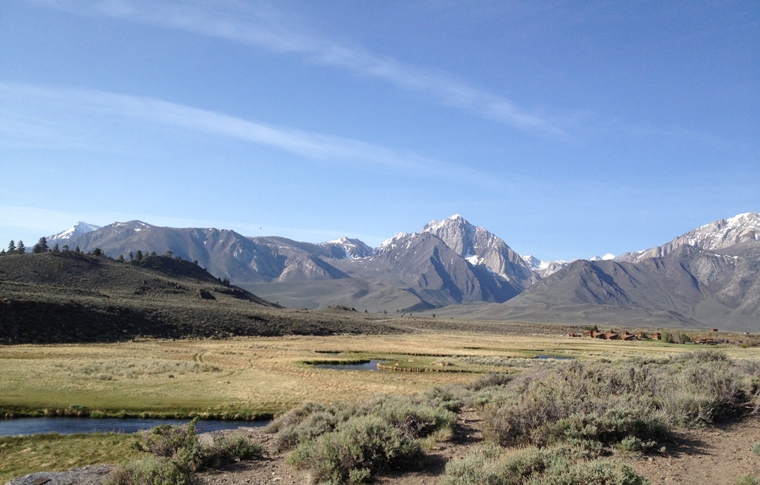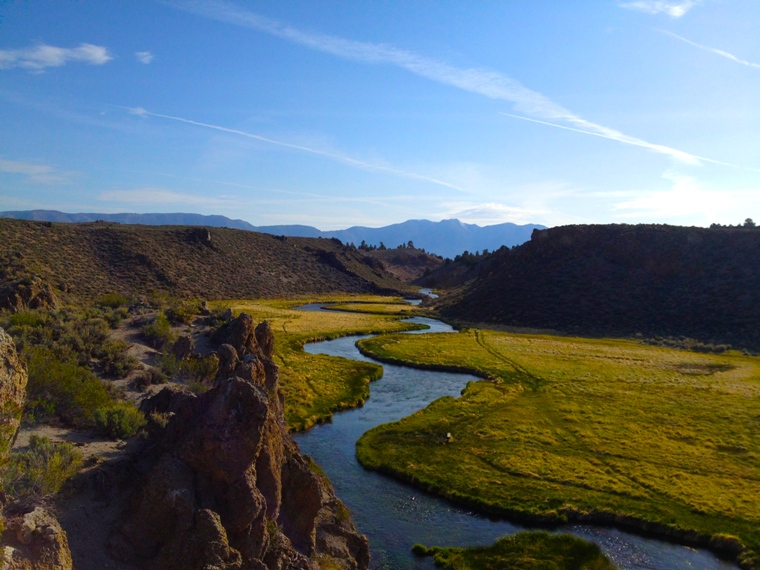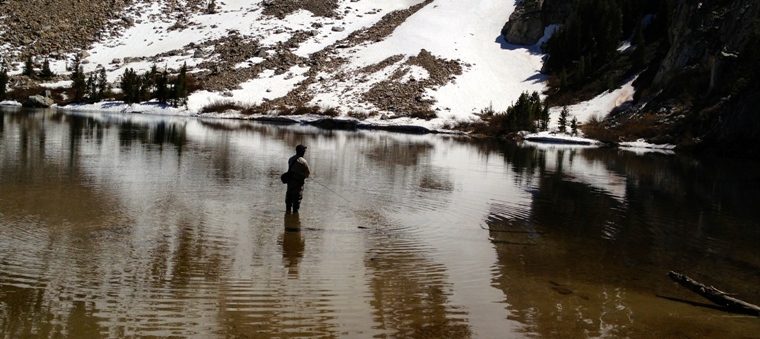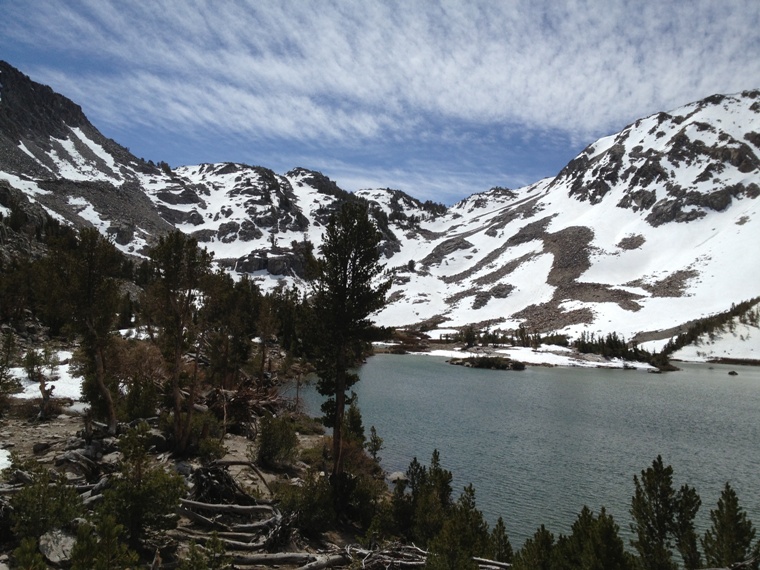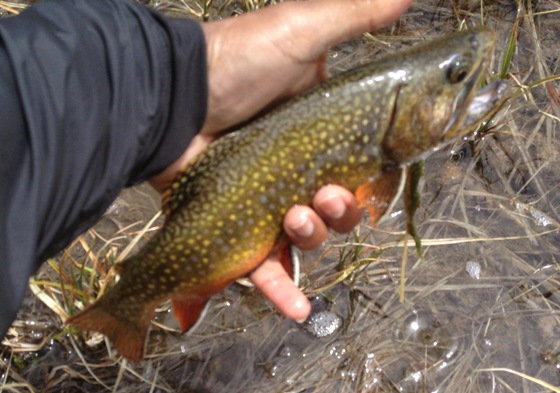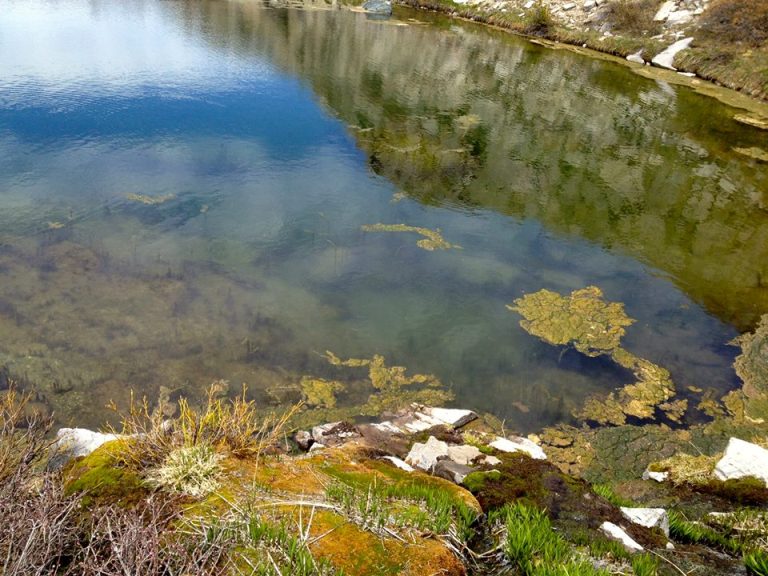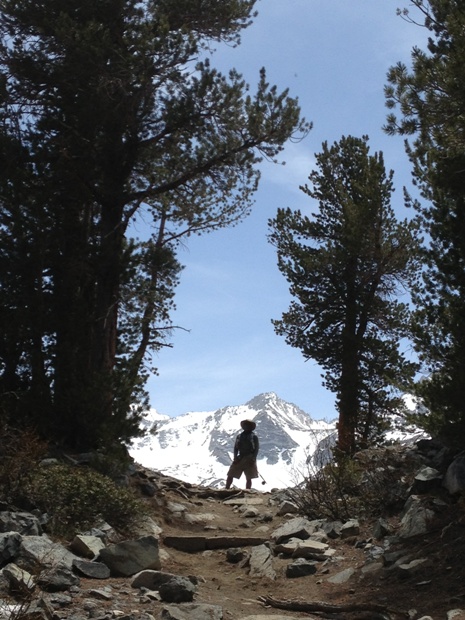|
|
|
|
|
May 24th to May 31, 2014- Hot Creeek Ranch, Ansel Adams Wilderness, Barney Lake, Little Lakes Valley
Time:
Generally Late Mornings / Early Afternoons Narrative: Hard to believe that Vita and I have been making the trek to the Eastern Sierra for nearly 2 decades and that Mike and I had been doing so before then. The details are hazy but in that time, the 5 hour drives from the Bay Area have brought with them many great memories and helped to develop many great friendships. Mike, Marlo, Josh, Gino, Bernard, Darrell, Ted, Erik, Ryan, Mark, Bob, Justin and Roger have all shared in the good times on Eastern Sierra streams and high country lakes- some of which have been documented here. Some of my favorite Eastern Sierra trips have been- the early years exploring the lakes with Gino and Josh, the year of Pleasant Valley trips with Mike, the first Hot Creek Ranch trip with Erik and any trip to the Cottonwood Lakes area. The extended backpacking trips are up there as far as favorites go but they’ve all been via Western routes into the high country. Then there are of course the 20 years of trips with Vita at my side. No fonder memories exist, nor stranger if I recall the McGee Creek experience in the late 90’s. (http://www.highcountryflyfisher.com/pages/chronJMW1.htm) Not always about fishing, not always not about fishing but always about spending quality time with the person I’ve chosen to spend the rest of my life with. Vita tolerates our 3 nights stay at Hot Creek Ranch and her tolerance is always reward with a 5 nights stay at a posh resort in Mammoth Lakes, complete with cable and room service. Typically, I get 3 days of fishing while at the ranch and another day or two once we transfer to Mammoth. Again, at Hot Creek Ranch it isn’t about the fish. In fact, last year and two years ago when Roger and I stayed at the Ranch, we barely fished the ranch at all. A waste of money? Perhaps but you can’t always “chase” fish and the fish at the ranch aren’t always willing to grab a fly. Why not simply fish the Ranch when they are? That’s my general attitude anyway but we’d spent more time not fishing Hot Creek in recent years and this being my first fishing trip of the season, I wanted to spend one solid day on the creek. That morning I’d run the length of the creek, in part to check it out and in part to get some trail running training in at altitude for my Fastpack and Fish plans this year. (More on that later.) The creek looked primed to produce good hatches and big fish. After breakfast Roger and I worked the area around the bluffs looking for active fish. It was the most crowded day on Hot Creek Ranch that I can remember. We had planned to fish lower down but that area was uncharacteristically crowded so we decided to pass. The bluffs usually produce but the fish just weren’t showing. We didn’t get skunked but given our history here, we expected better. I was happy to be out but I’ll admit that I probably didn’t have the patience and line control to fish as well as was probably needed. Sunday was Golden Trout day as it often is on these trips. A quick drive up to Saddlebag Lake revealed that it and likely all the lakes in the 20 Lakes Basin were still frozen- completely frozen. No icing out at Saddlebag, much to the chagrin of group of fisherman desperately trying to break up the ice by the dam. Of course at this time of year, one must always have a plan B. Plan B was a lake we knew held good fish in the Ansel Adams wilderness. You’d think that a guy that chronicles his fishing online would routinely review those chronicles before returning to fish those same waters again. Nope- doesn’t happen. I rely on memory…… which used to be just fine but my memory isn’t what it used to be and this trip basically played out like the last trip. Roger and I set up where we knew there can be some big fish. He fished where I fished last time and I fishing where he fished with the same result. He out fished me something like 10 to 1, even though we were fishing the exact same pattern. I had forgotten the lessons of my first trip here. My first trip here I learned that the fish were extremely spooky and that I had to fish an extremely long leader. Our second trip here we learned that the fish were extremely spooky and that they liked a fast retrieve if you could present the fly without spooking them. That first bit is the key and I didn’t pay it the respect it deserved. If I’m honest, I was fishing a bit carelessly because there was a ton of 8 to 12 inch fish actively feeding. I was playing the numbers and I lost. Roger of course wasn’t having these difficulties. Lesson learned. There are several important differences between how Roger and I were fishing. Roger was fishing an extremely long leader, 16 feet if I recall correctly and I was fishing my standard Hot Creek leader of 9ft. Roger was also fishing an intermediate sink line, ala Denny Rickards. And now as I write this, I recall that on my first trip here I had reverted to my intermediate sink leader. Normally this isn’t a deal breaker but on this lake the fish are extremely sensitive to surface disturbances. In time, I came to realize that during my retrieve, the wake created by the transition knot of my fly line and leader was spooking fish. Much like the last visit here, I was redeemed by the deeper water. Again, we were on our way out. I’d decided that I’d flailed the flat water long enough. I’d seen other fish on the lake on the way in; it was time to move. If it’s one thing I’ve learned in the high country, it’s never pass up near shore erratics- rocks, scattered along the shoreline like glacial erratics. Whether its here, Conness Lakes, Hilton Lakes or Thousand Island Lake, just don’t do it. They hold gold. We were essentially winding down the day, on our way out and I started fishing the submerged structure off shore when I happened to look down. “What do you know”, I thought to myself. I turned to Roger and said something like “I’ve got fish at my feet” and drop my beadhead hares ear at the base of the rock in front me. 3 Goldens rush out and I land my second fish of the day, a 10 or 12 inch fish similar to one that I’d caught earlier. My first fish that day was caught just as elegantly, by casting just my leader to a fish in the inlet creek. Not impressive fishing but effective. I caught the other 2 fish that were hiding under that rock both of which were smaller than the first and then proceeded to catch a bunch more fish hiding under rocks farther off shore. Cast out, let the fly sink to rock level, initiate retrieve, catch fish and repeat. It’s amazing how many places this pattern pans out. Monday was less than note worthy. After another training run from Hot Creek Ranch to Convict lake, Roger and I fished the Ranch again. We fished for maybe an hour. Patiently kneeling along the bank, casting to several rising fish in a tough back eddy- again with little success. This time it wasn’t for want of strikes; we simply didn’t hook up. The weekend was over for Roger and he headed home. I continued to fish Hot Creek with a little more patience this day. Sight fishing as best I could be with similar results to Saturday. That afternoon I visited the middle public area of the creek. An area I know well and typically do well on. In an hour or so I picked up a handful of fish to about 13 inches but nothing like my past success and not always in the places were I expected. It’s been a while since I’ve fished this portion of the creek hard and many of my favorite areas have filled in with silt and weeds. I need to come back again this summer and spend some quality time here. Once we leave Hot Creek Ranch, fishing takes a back seat and all but one day is about spending time with Vita. Even at Hot Creek, it’s less about fishing than one would think. We get out late, go back to the cabin early and typically only fish a few hours on the creek each day. Roger and Vita spend as much time doing their “foodie” thing, cooking and talking cooking as Roger and I do fishing. Vita isn’t really a mountain person and as I’ve said before, Hot Creek Ranch is as close to camping as she wants to get but each year we hike the Little Lakes Valley. We started doing this several years ago. We hiked into (and I fished) Mack Lake. Now, each year we go one lake farther. A few years later we hiked into Marsh Lake with her sister. Last year it was Heart Lake. This year it technically should have been Box Lake; but, I’d actually visited Box Lake last year when I found the fish at Heart on the small side. This year I was hoping Vita would be up for hiking to Long Lake.
She complained immediately, as she always does. The trail into the LLV starts at just over 10,000 feet above sea level and climbs immediately from the trailhead. Vita spends 51 weeks a year at 60 feet above sea level and most of the climbing she does is on the treadmill at the gym. We stopped and rested as much as we walked but when we got to Box Lake, she said to push on to Long Lake. What a trooper! Box Lake and all the lakes that preceded it on the trail were free of snow and ice but Long Lake was still icing out. With a ring of 20 to 30 feet of open water along the edge, I’d estimate that 75% of the lake was still covered with ice. I’ve often heard stories of big aggressive fish at ice out with fish hanging out under the ice- crushing anything that swims by. Sadly, I’ve never run into that scenario. That doesn’t mean the brookies at Long Lake weren’t willing to take a fly. Sight fishing on the lake was very good. Especially near the inlet. Fish to about 12 inches were showing. Vita explored and I fished. After about an hour we headed back down the trail. At the stream crossing I stopped. There was little bit of pocket water and I wanted to drop a fly in there and was rewarded. I’m definitely starting to get the small stream bug again. My fishing’s been too heavily weighted to lakes in recent years. I found Vita waiting for me at Box Lake and decided to wet wade my way close enough to make a few casts into the inlet channel. I could see fish fining in the water and as soon as my fly hit the water it was bedlam! Fish came out of the woodwork and charged the fly. For about 15 or 20 minutes I hooked a fish on each cast- decent sized rainbows. After about 30 minutes, the fish stopped moving for the fly and we moved on. The hike back to the car is easier than the hike in. It’s a net downhill but you couldn’t convince Vita of that. She complains every year but always returns to go "one lake further". The rest of the week was about road trips and shopping outlets. Thursday before shopping, I crushed myself on a 3 hours Fastpack and Fish training run. It was eye opening. The run to Convict Lake was tough and revealing in that I apparently wasn't as fit as I thought or can’t push myself beyond aerobic levels at altitude. (If you know anything about endurance sports, lets just say I was running at zone 2/ MAF and it felt like Zone 4/Threshold.) I don’t know what I was thinking with this run, well I do know what I was thinking. I was thinking I was at altitude and needed to take advantage of the training effects of being at altitude. A sea level a 3 hour easy run would be comfortably difficult for me. At altitude it was brutal. Why all the training or more appropriately, the continued training while in Mammoth? This year my fishing is going to focus a lot on what I’ve referred to here and I’m calling “Fastpack and Fish” trips. Simply put, putting on a light pack and running and power hiking my way into the backcountry with the idea of travelling farther on my standard day trips. Why run in and run out instead of backpacking? Well, truthfully I should probably be doing both but over the past few years I’ve focused on one long backpacking trip each year with lots of shorter day trip.
Friday was going to be my first Fastpack and Fish trip. I’d been milling over several destinations and finally settled on Duck Lake. I needed contingencies and the trail to Duck Lake would provide plenty of Plan B fishing if Duck Pass was impassable or the lake was frozen. It was only 5 or 6 miles from the trailhead, not outrageous for a day trip distance, even it I wasn’t running. There were plenty of alternative lakes on the way into Duck Lake and though I’d never been to Duck Lake, I knew the first half of the trail well. The condition of any high mountain pass in the early season is an unknown and my only true concern. The trail was in fairly good shape until Skelton Lake. At Skelton Lake the terrain steepens and things got a bit dicey. The trail from Skelton Lake to Barney Lake was covered with snow. Steep and icy, I lost the trail several times, made several zig zag attempts to find the it, back tracking where needed and eventually found my way. Just shy of Barney Lake I had the following dialogue with a backpacker that had just come over the pass.
“How’s Duck Pass?” I asked. “Clear on the other side.” He replied. “And this side……?” He looked at me in my light weight trail running shoes and ultra running pack and said….. “It’s covered” “What do think my chances are?” I shot back. “We’ll, I just passed 3 guys going up with crampons on.”
OK. Duck Lake was out. No problem, I knew the beta on Barney and Red so I’d fish those instead. Barney Lake was clear, though most of the far bank was covered with several feet of steep snow leading down to the lake. It may have taken a week but my fishing instincts were slowly returning. I crept up to the outlet slowly, using the shadows and tree’s for cover. Several fish were visible. Their fire orange bellies clearly identifying them as brook trout. I slowly walked down the outlet to Red Lake. More fish were visible at the inlet and these fish were visibly taking dry flies. I stayed low as I made my way close enough to make my cast. The first cast flopped to the water without turning over. Ok, maybe all my fishing instincts weren’t firing on all cylinders. The next cast spooked a few fish on the false cast. Ok. Noted and adjusted for. On the 3rd cast a beautiful 6 inch brookie came to hand. I was sight fishing and measuring the fishes interest with each cast. I made a several more casts with a caddis cripple but the fish didn’t seem all that interested. I’d get some response but I’m always hoping for a “move off their feeding lane, slam the fly before any other fish can” type of response. I scanned the water a bit and found a few largish shadows cruising near some fallen timber. I tied on a black ant, made the cast and a beautiful 10 inch Brook Trout broke from it’s cruising lane. I spent that afternoon walking Red Lake, sight fishing to cruising fish with a black ant. Late that afternoon, just before the clouds moved in, I spent a little time exploring Barney Lake. Barney was an interesting place- weedy with lots of structure. The areas you come to first along the trail seemed to have tons of 4 to 6 inch brook trout but there are bigger trout to be found. They were found and landed, so I’ll be back to work the water a little harder and explore the portion of the bank that was still covered in snow.
I made fast work of the return to the trailhead, at first glissading from Barney to Skelton Lake and then running the remainder of the trail where I could. Though cut short by the snow on Duck Pass, this trip made a first good test for my Fastpack and Fish kit. On Saturday, the drive back though Yosemite revealed that the Dana Fork was at a good fishing level. There’s still some snow to come down yet but we’re sure to have a low water summer. If you haven’t been in the high country yet, get out early and often.
Next John Muir Wilderness Chronicle Previous John Muir Wilderness Chronicle Chronicle Index
|

